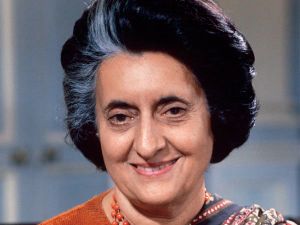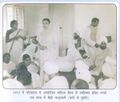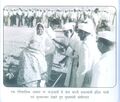Indira Gandhi
Indira Priyadarshini Gandhi, known by the name Indira Gandhi, Born 19 November 1917 – 31 October 1984) was an Indian politician and central figure of the Indian National Congress party, and to date the only female Prime Minister of India. Indira Gandhi was the only child of India's first Prime Minister, Jawaharlal Nehru. She served as Prime Minister from 1966 to 1977 and then again from 1980 until her assassination in 1984, making her the second-longest-serving Prime Minister after her father.
Gandhi served as her father's personal assistant and hostess during his tenure as prime minister between 1947 and 1964. She was elected Congress President in 1959. Upon her father's death in 1964, Gandhi refused to enter the Congress party leadership contest and instead chose to become a cabinet minister in the government led by Lal Bahadur Shastri. In the Congress Party's parliamentary leadership election held in early 1966, upon the death of Shastri, she defeated her rival, Morarji Desai, to become leader; and, thus, succeeded Shastri as Prime Minister of India.
As the Prime Minister of India, Indira Gandhi was known for her political ruthlessness and unprecedented centralisation of power. She went to war with Pakistan in support of the Independence movemen and war of independence in East Pakistan, which resulted in an Indian victory and the creation of Bangladesh, as well as increasing India's influence to the point where it became the regional hegemon of South Asia. She presided over a controversial state of emergency from 1975 to 1977 during which she ruled by decree. She was assassinated in 1984 by her Sikh bodyguards a few months after she ordered the storming of the Harmandir Sahib in Amritsar to counter the Punjab insurgency.
Contents
Early life and career
Indira Gandhi was born on 19 November 1917 in Allahabad. Her father, Jawaharlal Nehru, was a leading figure in India's political figure and became the first Prime Minister of the India. She was the only child (a younger brother was born, but died young), and grew up with her mother, Kamala Nehru, at the Anand Bhavan; a large family estate in Allahabad.
Indira was mostly taught at home by tutors, and intermittently attended school until matriculation in 1934. She was a student at the "Modern School" in Delhi and later, at International School of Geneva, and the Pupils' Own School in Poona and Bombay. She and her mother Kamala Nehru moved to Belur Math headquarters of Ramakrishna Mission where Swami Ranganathananda was her guardian later she went on to study at the Viswa Bharati University in Shantiniketan. It was during her interview that Rabindranath Tagore named her Priyadarshini, and she came to be known as Indira Priyadarshini Nehru. A year later, however, she had to leave university to attend to her ailing mother in Europe. After her mother died, she briefly attended the Badminton School before enrolling at Somerville College in 1937 to study history.
During her time in Europe, Indira was plagued with ill-health and was constantly attended by doctors. She had to make repeated trips to Switzerland to recover, disrupting her studies. She managed to enter England in early 1941, and from there returned to India without completing her studies at Oxford. In 2010, Oxford further honoured her by selecting her as one of the ten Oxasians, illustrious Asian graduates from the University of Oxford. During her stay in Great Britain, Indira frequently met her future husband Feroze Gandhi (no relation to Mahatma Gandhi), whom she knew from Allahabad, and who was studying at the London School of Economics. The marriage took place in Allahabad according to Adi Dharm rituals though Feroze belonged to a Zorastrian (Parsi) family of Gujarat.
In the 1950s, Indira, now Mrs. Indira Gandhi after her marriage, served her father unofficially as a personal assistant during his tenure as the first PM of India. Towards the end of the 1950s, Indira Gandhi served as the President of Cogress Party. In that capacity, she was instrumental in getting the Communist led Government of Kerala dismissed in 1959. That government had the distinction of being India's first ever elected Communist Government. After her father's death in 1964 she was appointed as a member of the Rajya Sabha (upper house) and became a member of Lal Bahadur Shastri's cabinet as Minister of Information and Broadcasting.
The first term as Prime Minister between 1966 and 1971
Following a poor showing in the Indian general election, 1967, Indira Gandhi started progressively moving to the left in the political spectrum. In 1969, after falling out with senior party leaders on a number of issues, the party president S. Nijalingappa expelled her from the party. Gandhi, in turn floated her own faction of the Congress party and managed to retain most of the Congress MPs on her side with only 65 on her own faction. The policies of the Congress under Indira Gandhi, prior to the 1971 elections, also included proposals for the abolition of Privy Purse to former rulers of the Princely states and the 1969 nationalization of the fourteen largest banks in India.
The biggest achievement of Indira Gandhi after the 1971 election was India's decisive victory in the Indo-Pakistani War of 1971, that led to the formation of independent Bangladesh. Some sources claim she was hailed as Goddess Durga by opposition leader Atal Bihari Vajpayee at that time. Vajpayee, though categorically denied ever having said that when he made an appearance in a TV show.
Despite the victory against Pakistan, the Congress government faced numerous problems during this term. Some of these were due to high inflation which was in turn caused by war time expenses, drought in some parts of the country and more importantly, the 1973 oil crisis. The opposition to Gandhi in 1973-75 period, after the Indira wave had receded, was strongest in Bihar and Gujarat. In Bihar, Jayaprakash Narayan, the veteran leader, came out of retirement to lead the protest movement there.
Verdict on electoral malpractice
On 12 June 1975, the High Court of Allahabad declared Indira Gandhi's election to the Lok Sabha void on grounds of electoral malpractice. In an election petition filed by Raj Narain (who later on defeated her in 1977 parliamentary election from Rae Bareily), he had alleged several major as well as minor instances of using government resources for campaigning. The court thus ordered her stripped of her parliamentary seat and banned from running for any office for six years. The Prime Minister must be a Member of parliament, either the Lok Sabha or the Rajya Sabha]] (the upper house). Thus, this decision effectively removed her from office. Gandhi had asked one of her colleagues in government, Mr. Ashoke Kumar Sen to defend her in court.
But Gandhi rejected calls to resign and announced plans to appeal to the Supreme Court. The verdict was delivered by Mr Justice Jagmohanlal Sinha at Allahabad High Court. It came almost four years after the case was brought by Raj Narain, the premier's defeated opponent in the 1971 parliamentary election. Indira Gandhi, who gave evidence in her defence during the trial, was found guilty of dishonest election practices, excessive election expenditure, and of using government machinery and officials for party purposes. The judge, however, rejected more serious charges of bribery against her.
State of Emergency (1975–1977)
Gandhi moved to restore order by ordering the arrest of most of the opposition participating in the unrest. Her Cabinet and government then recommended that President Fakhruddin Ali Ahmed declare a state of emergency because of the disorder and lawlessness following the Allahabad High Court decision. Accordingly, Ahmed declared a State of Emergency caused by internal disorder, based on the provisions of Article 352(1) of the Constitution, on 25 June 1975.
Rule by decree
Within a few months, President's Rule was imposed on the two opposition party ruled states of Gujarat and Tamil Nadu thereby bringing the entire country under direct Central rule or by governments led by the ruling Congress party. Police were granted powers to impose curfews and indefinitely detain citizens and all publications were subjected to substantial censorship by the Ministry of Information and Broadcasting. Finally, the impending legislative assembly elections were indefinitely postponed, with all opposition-controlled state governments being removed by virtue of the constitutional provision allowing for a dismissal of a state government on recommendation of the state's governor.
Indira Gandhi used the emergency provisions to change conflicting party members. Unlike her father Jawaharlal Nehru, who preferred to deal with strong chief ministers in control of their legislative parties and state party organizations, Mrs. Gandhi set out to remove every Congress chief minister who had an independent base and to replace each of them with ministers personally loyal to her...Even so, stability could not be maintained in the states...
1977 election and opposition years
In 1977, after extending the state of emergency twice, Indira Gandhi called elections to give the electorate a chance to vindicate her rule. Gandhi may have grossly misjudged her popularity by reading what the heavily censored press wrote about her. In any case, she was opposed by the Janata alliance of Opposition parties. Janata alliance, with Jai Prakash Narayan as its spiritual guide, claimed the elections were the last chance for India to choose between "democracy and dictatorship." The Congress Party split during the election campaign of 1977: veteran Gandhi supporters like Jagjivan Ram, Hemwati Nandan Bahuguna and Nandini Satpathy were compelled to part ways and form a new political entity, CFD (Congress for Democracy), primarily due to intra-party politicking and also due to circumstances created by Sanjay Gandhi. The prevailing rumour was that Sanjay had intentions of dislodging Gandhi and the trio stood between that. Gandhi's Congress party was crushed soundly in the elections. The public realized the statement and motto of the Janata Party alliance. Indira and Sanjay Gandhi both lost their seats, and Congress was cut down to 153 seats (compared with 350 in the previous Lok Sabha), 92 of which were in the South. The Janata alliance, under the leadership of Morarji Desai, came into power after the State of Emergency was lifted. The alliance parties later merged to form the Janata Party under the guidance of Gandhian leader, Jayaprakash Narayan. The other leaders of the Janata Party were Charan Singh, Raj Narain, George Fernandes and Atal Bihari Vajpayee.
In opposition and return to power
Since Gandhi had lost her seat in the election, the defeated Congress party appointed Yashwantrao Chavan as their parliamentary party leader. Soon afterwards, the Congress party split again with Gandhi floating her own Congress (I) faction. She won a by-election from the Chikamagalur constituency to the Lok sabha in 1978. However, the Janata government's Home Minister, Choudhary Charan Singh, ordered the arrest of her and Sanjay Gandhi on several charges, none of which would be easy to prove in an Indian court. The arrest meant that Indira Gandhi was automatically expelled from Parliament. These allegations included that she "‘had planned or thought of killing all opposition leaders in jail during the Emergency’". Malhotra, Inder. Indira Gandhi. New York: Coronet Books, 1991. However, this strategy backfired disastrously. Her arrest and long-running trial gained her great sympathy from many people. The Janata coalition was only united by its hatred of Gandhi (or "that woman" as some called her). The party included right wing Hindu Nationalists, Socialists and former Congress party members. With so little in common, the Morarji Desai government was bogged down by infighting. In 1979, the government started to unravel over the issue of dual loyalties of some members to Janata and the RSS. The ambitious Union Finance minister, Charan Singh, who as the Union Home Minister during the previous year had ordered arrest of Gandhi, took advantage of this and started courting the Congress (I). After a significant exodus from the party to Charan Singh's faction, Desai resigned in July 1979. Charan Singh was appointed Prime Minister, by President Reddy, after Indira and Sanjay Gandhi promised Singh that Congress (I) would support his government from outside on certain conditions., The conditions included dropping all charges against Indira and Sanjay. Since Charan Singh refused to drop the charges, Congress (I) withdrew its support and President Reddy dissolved Parliament in August 1979.
1980 elections and third term
The Congress (I) under Gandhi swept back to power in January 1980. Elections soon after to State assemblies across the country also brought back Congress ministries in the state with Indira's son Sanjay Gandhi choosing loyalists to lead the states. Sanjay died soon after in an air crash, early into this term. Sanjay Gandhi died instantly from head wounds in an air crash on 23 June 1980 near Safdarjung Airport in New Delhi. He was flying a new aircraft of the Delhi Flying club, and, while performing an aerobatic manoeuvre over his office, lost control and crashed. The only passenger in the plane, Captain Subhash Saxena, also died in the crash. Gandhi by this stage only trusted her family members and therefore decided to bring in her reluctant pilot son, Rajiv into politics.
Operation Blue Star
In the 1977 elections, a coalition led by the Sikh-majority Akali Dal came to power in the northern Indian state of Punjab. In an effort to split the Akali Dal and gain popular support among the Sikhs, Indira Gandhi's Congress helped bring the orthodox religious leader Jarnail Singh Bhindranwale to prominence in Punjab politics. Later, Bhindranwale's organisation Damdami Taksal became embroiled in violence with another religious sect called the Sant Nirankari Mission, and he was accused of instigating the murder of the Congress leader Jagat Narain. After being arrested in this matter, Bhindranwale disassociated himself from Congress and joined hands with the Akali Dal. In July 1982, he led the campaign for the implementation of the Anandpur Sahib Resolution, which demanded greater autonomy for the Sikh-majority state. Meanwhile, a small section of the Sikhs, including some of Bhindranwale's followers, turned to militancy after being targeted by government officials and police in support of the Resolution. After several futile negotiations, Indira Gandhi ordered the Indian army to enter the Golden Temple in order to confront those followers of Bhindranwale who had turned to militancy. Indian army used heavy artillery such as tanks and cannons and machine guns in addition with helicopters to crush the Sikhs of Harmindar Sahib. In the resulting Operation Blue Star, the shrine was damaged and many civilians were brutally massacred. Which started a swim of riot in Punjab and as a result many religious Sikh leaders as well as many devotees of Harminder Sahib were arrested, tortured and killed. Still there is a long list of missing persons from Sikh religious community of Punjab being abducted by state agencies, police and army. The State of Punjab was closed to international media, its phone and communication lines shut. To this day the events remain controversial with a disputed number of victims; Many Sikhs seeing the attack as unjustified and Bhindrawale being declared the greatest Sikh martyr of the 20th century by Akal Takht (Sikh Political Authority) in 2003.
Assassination
The day before her death (30 October 1984) Indira Gandhi visited Orissa where she gave her last speech at the then Parade Ground in front of the Secretariat of Orissa:
After her death, the Parade Ground was converted to the Indira Gandhi Park which was inaugurated by her son, Rajiv Gandhi.
On 31 October 1984, two of Gandhi's bodyguards, Satwant Singh and Beant Singh, shot her with their service weapons in the garden of the Prime Minister's residence at 1 Safdarjung Road, New Delhi. The shooting occurred as she was walking past a wicket gate guarded by Satwant and Beant. She was to have been interviewed by the British actor Peter Ustinov, who was filming a documentary for Irish television. Beant Singh shot her three times using his side-arm and Satwant Singh fired 30 rounds. Beant Singh and Satwant Singh dropped their weapons and surrendered. Afterwards they were taken away by other guards into a closed room where Beant Singh was shot dead. Kehar Singh was later arrested for conspiracy in the attack. Both Satwant and Kehar were sentenced to death and hanged in Delhi's Tihar Jail.
She was cremated on 3 November near Raj Ghat. The site where she was cremated is today known as Raj Ghat.
Gallery
पटियाला में आयोजित महिला कैंप-1955 में श्रीमती इंदिरागांधी के साथ श्रीमती चन्द्रावती
श्रीमती चन्द्रावती, इंदिरागांधी और बंशी लाल के साथ
References
Further reading
- Ved Mehta, A Family Affair: India Under Three Prime Ministers (1982) ISBN 0-19-503118-0]
- Pupul Jayakar, Indira Gandhi: An Intimate Biography (1992) ISBN 978-0-679-42479-6]]
- [Inder Malhotra, Indira Gandhi: A personal and political biography (1991) ISBN 0-340-53548-2]
- Indira Gandhi – Iron Lady of India by Dr Sulakshi Thelikorala
- [[[Midnight's Children]], Salman Rushdie]
External links
Photo Gallery












